Dublin, Ireland - 2016

Convention Center and Beckett Bridge
(Click any image to see it full size.)
Dublin, Ireland - 2016

Convention Center and Beckett Bridge
(Click any image to see it full size.)
It was easy to check out Dublin. Aer Lingus stops there on its way everywhere, so we got off the plane for a few days of truly happy wandering. The city is a comfortable size, at half a million. The downtown area is huge, spread over several old, cramped neighborhoods. There is a river, The Liffey, dividing the north side from the south side, and a good dozen bridges, all different styles, crossing it. What we found was happy. Everyone was happy Ė to see us, to greet us, to help us, to converse with us, from the market stall sellers to the pub performers, itís a no-barrier kind of place. You get on the Air Link bus (Number 747. Brilliant.) for six euros, and it takes you right into town, stopping at all the right places.
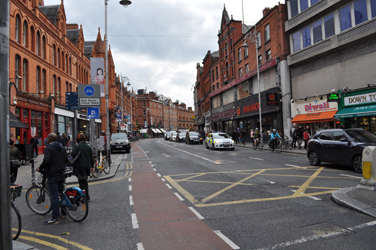 |
 |
 |
| Shopping street in creative district | Clean and inviting | St. Stephen's Green |
We stayed at the Westin, which could not be better placed if they tried. Itís an old, converted bank onWestmoreland, right across the street from the Temple Bar pub area, right up the street from the major shopping area Grafton Street, and beside Trinity College. Dublin is chock full of kids from all over the world. There are more hostels than weíve seen anywhere, and just thousands of kids going to classes and drinking the night away. Because itís Dublin, where, as the sandwich board says: Soup of the day: whiskey. The neon in the window says: Get in here NOW.
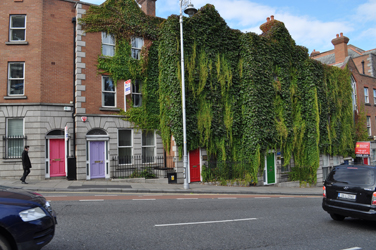 |
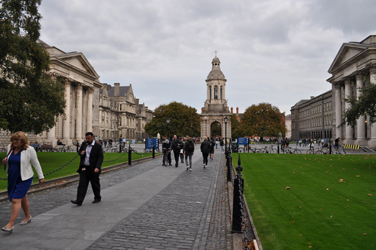 |
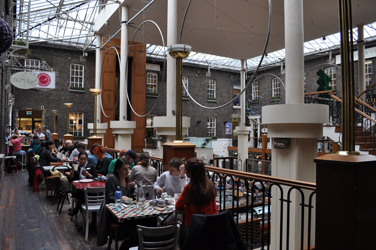 |
| Massive ivy, coloful doors | Trinity College | Powerscourt mixed use |
The Guinness Storehouse Museum (and I canít believe Iím writing this) is not to be missed. The brewery is a gigantic complex of dozens of huge buildings in the west end, past the historic district. The biggest building, a brick and steel girder storehouse, is a museum: seven floors of beer lore, retail and food. The actual machines are there, with video guided tours of what they do. The making of the barrels was my favorite. Each barrel requires a dozen tools you never heard of, and the cooper doesnít take a single measurement until he uses a compass to scratch out a circle for the top (which he then hacks to size). Thereís a floor dedicated to their world-class beer ads, a tastings area, a mixology area where you can pervert your own beer, and a circular glassed-in bar on top, where your ticket gets you a pint of Guinness and the best view of town. Thankfully, it doesnít rotate.
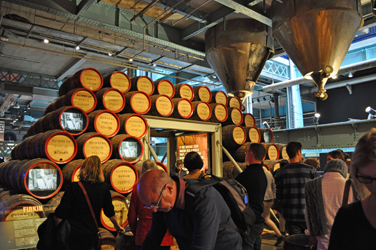 |
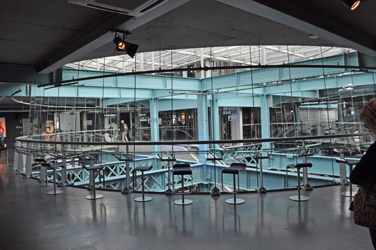 |
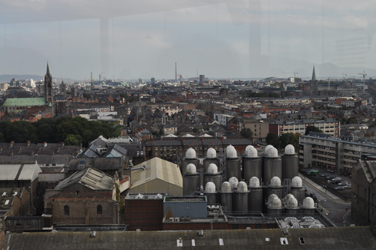 |
| Guinness Barrels | Guinness Storehouse | Guinness View |
And despite Irelandís (and the UKís) reputation for nothing-special food, we ate really well. The Winding Stair is a two floor creaking walkup on the north side, just off the Haípenny Bridge. It had such an unusual menu, we absolutely had to stop in. We were not disappointed, but rather, enchanted. The talk was boisterous, and the crowd was having a great time. It is both a restaurant and a bookstore on the ground level. It works.
We had a similar experience at Fallon and Byrne on Exchequer, in the creative district of endless restaurants, bars, galleries and stores. The length of the wall is filled with wine Ė about 4000 bottles. You pick one, and they charge you a one euro corkage fee to have it with dinner (Itís mainly a lovely, award-winning retail food store, wine store and food hall). This place has communal tables, and a crowd at least as loud as The Winding Stair. We tried the scones in half a dozen bakeries as we walked. No need for the hop-on hop off thing Ė you miss too much. The cheapest food was in the market on the north side Ė same quality, and more international, but less expensive. The stores are still largely local one-offs, which gives them character, and an unusual stock of goods. We saw The Dublin Yeast Store, with old fashioned baking accessories, the Knob and Knocker Store, a fountain pen store, a Gaelic Record Shop, and even the last Tower Records store Ė now 100% Irish. There are numerous welcoming bookstores, and all kinds of crafts. It is not like any other western capital in that respect.